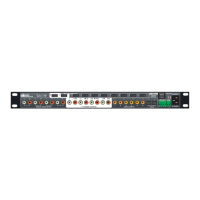Page 22
Setup 1 - Speaker Size & Crossover Frequency
The Suite 7.1 HD uses the description of Small (SM), Large (LG), and None (NO) with respect to the
speakers. Small refers to speakers that are not designed to handle low frequencies. Bass information
is redirected to the subwoofer. Large refers to speakers that are capable of playing low frequencies.
No bass redirection takes place. None refers to that speaker not existing in your system (i.e. no back-
center surround speakers)
There is another Suite 7.1 HD feature that works in conjunction with SMALL settings called Sub Cross-
over (SUB) which refers the Sub Woofer crossover frequency point that determines at which frequency
the Small speakers’ bass information is “rolled off” and sent to the subwoofer. Speakers that are set
to Large are never rolled off. The crossover frequency point is fully adjustable per speaker group on
the Suite 7.1 HD. Speakers are grouped together accordingly: Front Right & Left, Center, Surround
Right & Left, Back Surround Right & Left, and Subwoofer.
THX Rated or Small Speakers
If you are using THX speakers, most such speaker designs are purposely engineered to not handle
low frequencies because the subwoofer is providing all of the bass sound reinforcement. The typical
crossover frequency point for THX speaker is 80Hz (Hertz). In a THX speaker system, all bass infor-
mation below 80Hz intended for the left, center, right, surround left, surround right, back surround left,
and back surround right speakers is redirected to the subwoofer and summed (combined) with the LFE
(Low Frequency Effects or the “.1” in a 5.1 mix). As such, these speakers are rolled off at 80Hz.
Full Range or Large Speakers
If you have a mix of home theater speakers and full-range speakers (speakers that can handle bass),
you can opt to set some speakers to the Large setting and other speakers to the Small setting. Note
that speakers set to Large do not have any of their bass information sent to the subwoofer - the speaker
most likely best capable of producing low frequency sounds.
ADA generally recommends that all speakers are set to small for the optimum theater experience,
even if some of your speakers are full range. This suggestion coincides with the understanding that
your system contain at least one subwoofer which is usually better suited for bass reproduction. Most
bass information in lm content is mixed into the front left and right channels as well as the “.1” LFE
channel. By directing all of the bass information to the subwoofer, you will create a more theater-like
experience.
While systems can be run in a phantom mode, where the center channel information is redirected to
the front right and left speakers, ADA strongly suggests that you utilize a center channel speaker in
your system. As this channel handles mostly dialogue, it is an important speaker in your system.
When trying to decide what type of surround speakers to utilize, either dipole or directional speakers,
there is much discussion as to which will perform better with 5.1 digital source material. Some sug-
gest placing directional speakers in the back left and right corners. While this will work, if you are also
employing back-surround speakers in addition to left and right surround speakers, you will most likely
have a better sound eld with dipole speakers placed at the listening position slightly above head level.
You can then opt for directional or dipole speakers for the back-surround channels.
When employing back surround speakers, you will need to determine if you are using one or two
speakers. If the back wall of the theater is not very wide, you may opt to include a single speaker
in the middle. If the rear wall is wide, you can include two speakers evenly spaced along the back
wall. The Suite 7.1 HD permits you to have two, one, or no back-surround speakers. Please note,
you always have surround speakers even if you locate them along the back wall. The “back surround
speakers” are in addition to “surround speakers”.

